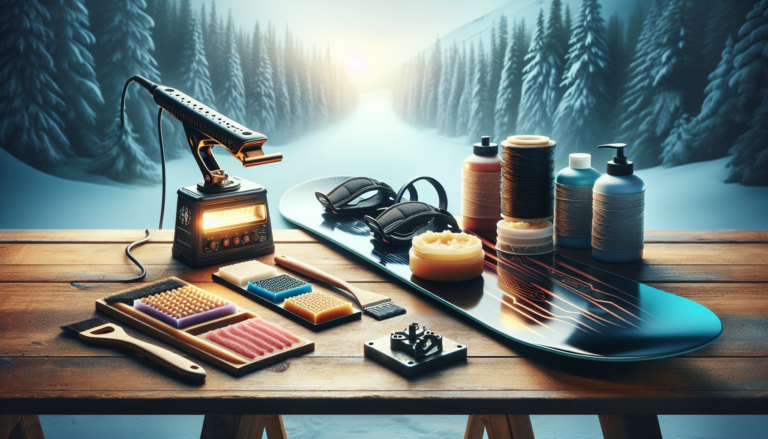Introduction to Snowboard Waxing
Waxing your snowboard is an essential part of maintaining its performance and longevity. Applying wax to the base of your board helps it glide smoothly over the snow, improves speed, and protects the base from damage. However, many riders may wonder, “how often should I wax my snowboard?” The answer depends on several factors, but following a regular snowboard maintenance routine that includes waxing can keep your board in top condition.
To understand the importance of snowboard waxing frequency, it’s helpful to know why waxing is necessary in the first place. The base of your snowboard is made of a porous material that can dry out over time, especially when exposed to the elements. Wax fills in these pores, creating a smooth, hydrophobic surface that repels water and allows your board to glide effortlessly. Without regular waxing, your board’s base can become dry, rough, and slow, making it harder to control and less enjoyable to ride.
Why Waxing Your Snowboard is Important
Waxing your snowboard serves several critical purposes that contribute to its overall performance and lifespan. First and foremost, wax helps your board glide smoothly and quickly over the snow by reducing friction between the base and the snow surface. A well-waxed board will be faster, more responsive, and easier to control, allowing you to ride with greater precision and confidence. Wax also protects your board’s base from abrasion, scratches, and damage caused by rocks, ice, and other debris on the mountain.
Additionally, regular waxing helps prevent your board’s base from drying out and oxidizing, which can lead to permanent damage over time. When a snowboard base dries out, it becomes brittle and prone to cracking, which can be difficult or impossible to repair. Applying wax keeps the base moisturized and supple, preventing this type of deterioration and extending the life of your board. Given the significant investment that a snowboard represents, taking the time to wax it regularly is a small price to pay for optimal performance and longevity.
General Recommendations for Waxing Frequency
So, how often should you wax your snowboard? As a general rule of thumb, it’s a good idea to wax your board every 3-5 full days of riding, or about once every 5-10 individual sessions. This snowboard waxing frequency strikes a balance between maintaining your board’s performance and not spending too much time or money on waxing. If you ride more frequently or in particularly harsh conditions, you may need to wax more often. Conversely, if you only ride occasionally or in milder conditions, you may be able to go longer between waxings.
It’s also important to note that the type of wax you use can affect how often you need to apply it. Softer, temperature-specific waxes may wear off more quickly and require more frequent application, while harder, all-temperature waxes may last longer. Ultimately, the best way to determine your ideal waxing frequency is to pay attention to your board’s performance and appearance. If you notice that your board is starting to feel slow or sluggish, or if the base looks dry and chalky, it’s probably time for a fresh coat of wax.
Factors Influencing Waxing Frequency
While the general recommendations outlined above provide a useful starting point, there are several factors that can influence how often you should wax your snowboard. Understanding these variables can help you fine-tune your waxing frequency to suit your specific needs and riding style.
Riding Conditions and Their Impact
The snow conditions you typically ride in can have a significant impact on how quickly your board’s wax wears off. If you frequently ride in wet, slushy snow or in warmer temperatures, your wax will tend to wear off more quickly due to the increased moisture and friction. Similarly, if you often ride in icy or hard-packed conditions, your board’s base will experience more abrasion, which can also accelerate wax wear. In these situations, you may need to wax your board more frequently to maintain its performance and protect its base.
On the other hand, if you primarily ride in colder, drier conditions or in light, fluffy powder, your wax will tend to last longer. The colder temperatures and lower moisture content of the snow put less strain on your board’s base, allowing the wax to remain effective for a greater number of sessions. In these conditions, you may be able to go longer between waxings without noticing a significant drop in performance.
Board Material: Sintered vs. Extruded Bases
The type of base material your snowboard is made of can also affect how often it needs to be waxed. Snowboards typically have either a sintered base or an extruded base, each with its own characteristics and maintenance requirements.
Sintered bases are made by compressing and heating polyethylene pellets to create a dense, porous material. These bases are faster, more durable, and hold wax better than extruded bases, but they also require more frequent waxing due to their porous nature. In general, snowboards with sintered bases should be waxed every 2-3 days of riding to maintain optimal performance.
Extruded bases, on the other hand, are made by melting and cutting polyethylene into sheets, resulting in a less porous, more budget-friendly base material. While extruded bases are slower and less durable than sintered bases, they are also less demanding in terms of maintenance. Snowboards with extruded bases can typically go 7-10 days of riding between waxings, making them a good choice for casual riders or those who prefer a lower-maintenance board.
Usage Frequency and Riding Days
The more frequently you ride, the more often you’ll need to wax your snowboard. If you’re a dedicated rider who hits the slopes multiple times a week or participates in long, intensive riding sessions, your board will experience more wear and tear, requiring more frequent waxing to maintain its performance. In this case, you may need to wax your board every 2-3 riding days to keep it in top condition.
Conversely, if you only ride occasionally or for shorter sessions, you may be able to go longer between waxings. Recreational riders who hit the mountain a few times a season can often get away with waxing their board every 5-7 riding days, or even once at the beginning and once at the end of the season. However, even if you don’t ride frequently, it’s still a good idea to wax your board at least a couple of times a year to keep the base from drying out and to ensure it’s ready to go when you are.
Signs Your Snowboard Needs Waxing
While following a regular waxing schedule based on your usage and conditions is a good way to keep your snowboard in top shape, it’s also important to be aware of the signs that your board may need waxing sooner than planned. By keeping an eye out for these indicators, you can address any issues before they have a significant impact on your board’s performance and longevity.
Slow Glide and Performance Degradation
One of the most noticeable signs that your snowboard needs waxing is a decrease in its speed and responsiveness on the snow. If you find that your board feels sluggish, sticky, or harder to control than usual, it’s likely that the base has become dry and is in need of fresh wax. A well-waxed board should glide smoothly and effortlessly across the snow, allowing you to maintain speed and make precise turns with minimal effort. If you’re having to work harder than usual to keep your board moving or to initiate turns, it’s probably time to break out the wax.
Another related sign of a board in need of waxing is a general decline in performance across different snow conditions. If your board seems to be struggling in a variety of terrain, from hard-packed groomers to soft powder, it may be due to a lack of wax rather than any specific snow condition. A dry, unwaxed base will have a harder time adapting to changing snow types and temperatures, resulting in a less versatile and less enjoyable riding experience overall.
Visible Base Dryness
In addition to the performance-related signs, there are also visual cues that can indicate your snowboard is due for a waxing. One of the most obvious is a dry, chalky appearance to the base material. A properly waxed base should have a smooth, glossy finish that reflects light and appears slightly wet to the touch. If your board’s base looks dull, whitish, or fuzzy, it’s a clear sign that it’s time for a fresh coat of wax.
Another visual indicator of a base in need of waxing is the presence of visible scratches, gouges, or discoloration. While some minor scratches are inevitable over the course of a season, deep scratches or an overall “beat-up” appearance can indicate that your board’s base is no longer adequately protected by wax. Applying a fresh layer of wax can help fill in these scratches and restore your board’s appearance and performance.
DIY vs. Professional Waxing
Cost-Effectiveness of DIY Waxing
One of the main advantages of DIY snowboard waxing is the potential for significant cost savings over time. While the initial investment in waxing tools and supplies may seem daunting, it quickly pays for itself when compared to the cost of professional waxing services. A basic waxing kit, including an iron, scraper, and a few bars of wax, can typically be purchased for around $100, which is roughly the equivalent of 5-6 professional waxing sessions. Once you have your kit, the only ongoing expense is the cost of wax, which is relatively inexpensive when purchased in bulk.
To put the cost savings in perspective, let’s consider a typical season for an avid snowboarder. If you ride an average of 20 days per season and get your board professionally waxed before each trip at a cost of $20 per waxing, you’ll spend around $400 on waxing services alone. In contrast, if you choose to wax your own board using a $100 kit and $50 worth of wax, your total waxing expenses for the season will be only $150, a savings of $250. Over the course of several seasons, these savings can really add up, making DIY waxing a smart choice for budget-conscious riders.
Steps for DIY Waxing
If you’re interested in waxing your own snowboard, the process is relatively simple and straightforward. Here are the basic steps involved:
- Clean your board’s base: Use a base cleaner to remove any dirt, debris, or old wax from the base of your snowboard. This will help the new wax adhere better and last longer.
- Apply the wax: Using a waxing iron set to the appropriate temperature for your wax, drip a thin, even layer of wax onto the base of your board. Be sure to cover the entire base, including the edges.
- Let the wax cool: Allow the wax to cool and harden on the base of your board for at least 30 minutes. This will help it penetrate deeper into the base material for better performance and durability.
- Scrape the excess wax: Using a plastic scraper, remove any excess wax from the base of your board, leaving only a thin, smooth layer behind. Work from tip to tail, keeping the scraper at a 45-degree angle to the base.
- Brush the base: Using a stiff-bristled brush, brush the base of your board from tip to tail to remove any remaining wax residue and create a smooth, polished finish. This will help your board glide more efficiently on the snow.
With a little practice and patience, anyone can learn to wax their own snowboard effectively. Not only will you save money in the long run, but you’ll also have the satisfaction of knowing that your board is always in top condition and ready to ride at a moment’s notice.
When to Opt for Professional Waxing
While DIY waxing is a great option for most riders, there are some situations where it may be worth considering professional waxing services. One such scenario is if you’re a beginner or less experienced rider who is uncomfortable with the idea of working on your own equipment. Professional technicians have the knowledge, skills, and tools to properly wax your board, ensuring that it’s in optimal condition for your next trip to the mountain.
Another situation where professional waxing may be preferable is if you have a high-end or specialty snowboard that requires specific care and attention. Some boards, such as those with sintered bases or intricate graphics, may benefit from the expertise of a professional who knows how to properly maintain and protect these features. Additionally, if your board has any significant damage, such as deep scratches or gouges, a professional may be better equipped to repair and restore the base before applying a fresh coat of wax.
Ultimately, the decision between DIY and professional waxing comes down to your personal preferences, budget, and level of comfort with snowboard maintenance. If you enjoy the process of working on your own gear and don’t mind putting in a little extra time and effort to save money, waxing your own board can be a rewarding and cost-effective option. However, if you prefer the convenience and peace of mind that comes with professional services, there’s no shame in leaving the waxing to the experts.
Environmental Considerations
Choosing Eco-Friendly Wax Options
As a snowboarder, it’s important to consider the environmental impact of the products we use, including the wax we apply to our boards. Traditional ski and snowboard waxes are often made from petroleum-based ingredients that can be harmful to the environment, especially when they rub off onto the snow and eventually make their way into local waterways. Fortunately, there are now many eco-friendly wax options available that offer comparable performance without the negative environmental consequences.
When shopping for environmentally friendly snowboard wax, look for products that are made from natural, biodegradable ingredients such as soy, vegetable oil, or beeswax. These plant-based waxes are renewable, non-toxic, and break down quickly in the environment, minimizing their impact on local ecosystems. Some eco-friendly waxes are even certified by organizations like the USDA BioPreferred program, which verifies that the product contains a certain percentage of bio-based ingredients.
In addition to choosing eco-friendly wax, there are other steps you can take to minimize the environmental impact of your snowboard maintenance routine. For example, when scraping excess wax from your board, be sure to collect the scrapings and dispose of them properly in the trash rather than letting them fall onto the ground. You can also opt for reusable or biodegradable scraping and brushing tools rather than disposable plastic ones. By making small changes like these, we can all do our part to keep the mountains clean and pristine for future generations of riders.
Community Insights and Tips
Popular Discussions on r/snowboarding
One of the best ways to learn more about snowboard waxing and other maintenance topics is to connect with other riders and tap into the collective knowledge of the snowboarding community. Online forums like Reddit’s r/snowboarding are a great place to start, with over 1.6 million members sharing their experiences, tips, and advice on all things snowboarding.
Some of the most popular discussions on r/snowboarding related to waxing include debates about the ideal frequency of waxing, comparisons of different wax brands and types, and tips for perfecting your DIY waxing technique. Many users also share photos and videos of their waxing setups and results, providing visual inspiration and guidance for those looking to improve their own skills.
One particularly informative thread on r/snowboarding features user FL_Boarder asking for advice on how often to wax their board and how much it typically costs. In response, user WasatchMan suggests learning to wax your own board to save money, while user Honeycomb chimes in with a recommended waxing frequency of every 3-4 days on the mountain. By participating in discussions like these, you can gain valuable insights and perspectives from experienced riders around the world.
Expert Advice from Experienced Riders
In addition to the general discussions on r/snowboarding and other forums, there are also many experienced riders and industry professionals who share their expert advice on snowboard maintenance and waxing. For example, Nate, a blogger and gear reviewer at The Good Ride, recommends a basic waxing frequency of every 3-5 full days on the mountain, with more frequent waxing for riders who are particularly hard on their boards or who frequently ride in warm, slushy conditions.
Another respected voice in the snowboarding community is BClarke1828, an admin moderator on r/snowboarding who has been riding for over a decade. In one discussion about waxing tools, BClarke1828 recommends using a high-quality iron and a range of scraping and brushing tools to get the best results. They also stress the importance of reading the manufacturer’s recommended temperature range when applying wax to avoid damaging your board’s base.
By seeking out expert advice from experienced riders and industry insiders, you can gain a deeper understanding of the nuances of snowboard waxing and maintenance, and avoid common mistakes that can negatively impact your board’s performance and longevity. Whether you’re a seasoned rider or just starting out, there’s always more to learn from the collective wisdom of the snowboarding community.
#ED#






